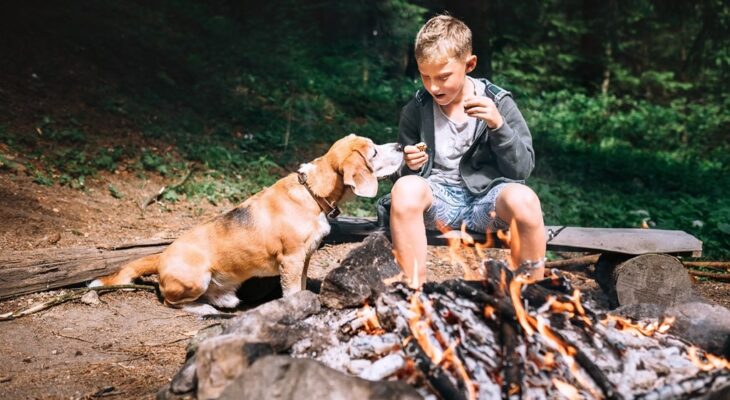For outdoor enthusiasts, the joy of camping and hiking is only enhanced when shared with a faithful four-legged companion. Camping and hiking with pets create memorable experiences, fostering a deeper bond between humans and their furry friends. However, embarking on outdoor adventures with pets requires thoughtful preparation and consideration of their well-being. In this article, we’ll delve into tips and tricks for camping and hiking with pets, ensuring a safe and enjoyable outdoor experience for both you and your loyal adventure companion.
1. Know Your Pet’s Abilities:
Before venturing into the great outdoors, assess your pet’s physical abilities and temperament. Consider their age, fitness level, and any health conditions. Not all pets are natural adventurers, so tailor your outdoor activities to match your pet’s capabilities. Puppies and older dogs, for example, may have different energy levels and requirements.
2. Visit the Vet:
A pre-adventure visit to the veterinarian is crucial to ensure your pet is healthy and up-to-date on vaccinations. Discuss your travel plans, and inquire about preventive measures for ticks, fleas, and other potential outdoor hazards. Ensure your pet is microchipped and has proper identification tags with current contact information.
3. Pack Essentials for Your Pet:
Just like humans, pets have specific needs when it comes to camping and hiking. Pack a separate bag for your pet that includes:
- Food and water: Bring sufficient pet food for the entire trip, as well as collapsible bowls for easy feeding and hydration.
- Leash and collar: Even if your pet is well-behaved off-leash, it’s crucial to have a leash for safety during unexpected situations.
- Bedding and comfort items: A familiar blanket or bed can provide comfort and a sense of security for your pet.
- First aid kit: Include pet-specific first aid items, such as antiseptic wipes, bandages, and any necessary medications.
4. Choose Pet-Friendly Trails and Campgrounds:
Not all trails and campgrounds are pet-friendly, so research and choose destinations that welcome furry companions. Look for trails with moderate difficulty levels suitable for your pet’s abilities. Check campground regulations regarding pet policies, leash requirements, and designated pet areas.
5. Training and Recall Commands:
Basic training commands are essential for the safety of both your pet and others in the outdoors. Ensure your pet responds to commands like “stay,” “come,” and “leave it.” This is particularly crucial in encounters with wildlife, other pets, or potentially hazardous situations.
6. Respect Wildlife and Other Campers:
Wildlife encounters can be unpredictable, and some animals may perceive pets as a threat. Keep your pet on a leash in areas where encounters with wildlife are possible. Additionally, be considerate of other campers and hikers by keeping your pet well-behaved and minimizing noise.
7. Protect Paws and Pads:
Pets’ paws are sensitive to rough terrain, hot surfaces, and sharp objects. Consider using pet booties to protect their paws during hikes. Alternatively, apply a pet-safe paw balm before and after outdoor activities to prevent injuries and soothe any irritation.
8. Provide Adequate Rest and Shade:
Pets, especially dogs, may not show signs of fatigue easily, making it crucial for you to monitor their activity levels. Allow for regular breaks in shaded areas, especially during hot weather. Carry a portable pet shade or create a makeshift shelter with a lightweight tarp.
9. Ensure Comfortable Sleeping Arrangements:
Whether camping in a tent or RV, ensure your pet has a comfortable and secure sleeping space. Bring their bed or blanket to create a familiar and cozy environment. Familiarize your pet with the camping gear beforehand, so they are comfortable during the night.
10. Pack Waste Disposal Bags:
Responsible pet ownership includes proper waste disposal. Pack enough waste disposal bags to pick up after your pet during hikes and around the campsite. Many outdoor areas have specific rules about pet waste, and adhering to them helps maintain the cleanliness of the environment.
11. Monitor Weather Conditions:
Weather conditions can impact your pet’s well-being. Consider your pet’s tolerance to heat or cold and plan activities accordingly. During hot weather, hike early in the morning or late in the evening to avoid peak temperatures. In cold weather, ensure your pet stays warm with appropriate gear.
12. Bring Entertainment and Comfort Items:
Keep your pet entertained and comfortable during downtime at the campsite. Bring their favorite toys, a chew toy, or a puzzle feeder to provide mental stimulation. Familiar items from home, like a favorite blanket or toy, can help your pet feel secure in a new environment.
13. Practice Leave No Trace:
Adhere to Leave No Trace principles by minimizing your impact on the environment. Pack out all pet waste, follow designated trails, and avoid disturbing wildlife. By practicing responsible outdoor habits, you contribute to the preservation of natural spaces for future adventurers.
14. Stay Hydrated:
Hydration is essential for both you and your pet during outdoor activities. Ensure your pet has access to clean water at all times, especially after exertion. Collapsible pet water bowls are convenient for on-the-go hydration.
Conclusion:
Camping and hiking with pets can be a rewarding and enriching experience, deepening the bond between you and your furry companion. By prioritizing their safety, comfort, and well-being, you create a positive environment for shared adventures. Whether exploring scenic trails, setting up camp under the stars, or simply enjoying the tranquility of nature together, the great outdoors becomes an even more special place when shared with a beloved pet.











